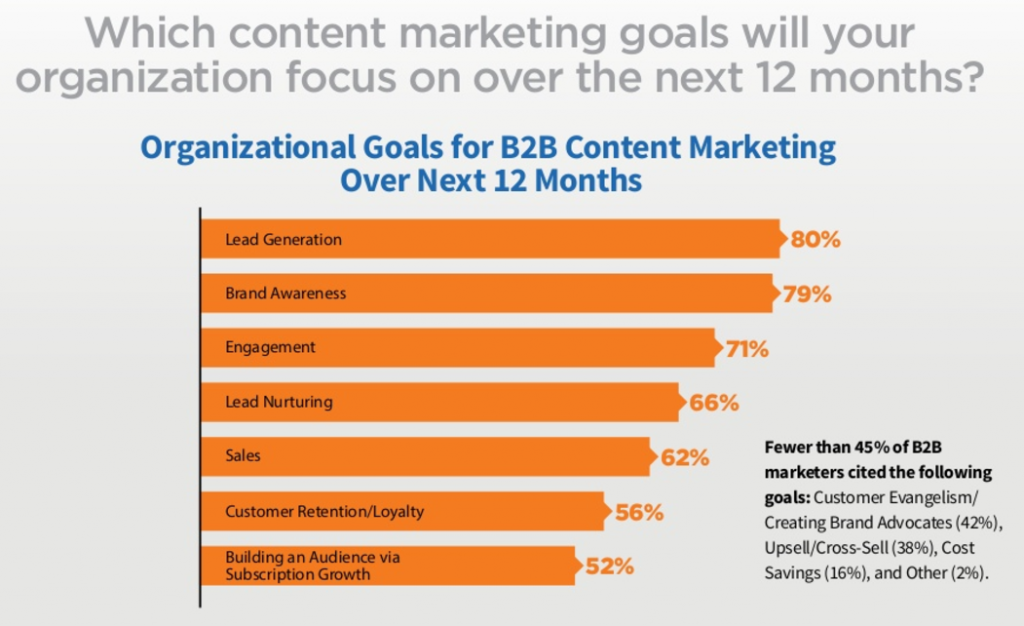
Content marketing is a must and everyone knows it. But the goal shouldn’t be to do content for content’s sake. Content marketing is a long-term technique that actually delivers results – given you have a documented strategy. And yes, it works for leads too! To the point where lead generation has become the most important goal for B2B content marketers in 2017, according to Content Marketing Institute.
Source: B2B Content Marketing 2017 – Benchmarks, Budgets & Trends – North America, CMI
As we like to say: “All content should convert…” but how?
To answer that question, I asked around. I wanted to know the little secrets of marketers who are reputed in their industry and who have been able to deliver amazing content on a variety of topics – lead generation being one of them. (Plus, I added a few words from our CEO Guillaume!)
Let’s hear what these marketing rockstars have to say 🙂

1. Include other experts within your content
Sweta Patel says…
 “The number one way to generate leads from your content is through crowdsourcing content and including other experts within your content. I find that if I go after thought-leaders who have the same audience I want to capture it is a lot easier to convert them into qualified leads. The thought-leader has a great deal of authority and it is feasible to instantly build credibility with others.”
“The number one way to generate leads from your content is through crowdsourcing content and including other experts within your content. I find that if I go after thought-leaders who have the same audience I want to capture it is a lot easier to convert them into qualified leads. The thought-leader has a great deal of authority and it is feasible to instantly build credibility with others.”
Sweta Patel, Director of Demand Generation
2. Help your audience solve their problems
Hans van Gent says…

“Content marketing is just solving the same problems that your product solves through media you create and promote.
So if you want to generate leads, you always got to start with helping your target audience. Helping them solve their problems. Giving away, sharing your knowledge so that you can empower them.
After you’ve created enough content, you can then start “bundling” your content and creating lead generators from it like webinars, eBooks, case studies, etc. and use these as lead generators
But it all starts with helping your audience solve their problems. By doing so, you build trust in your company, your products and services well enough that they also trust you with their email address or other forms of contact information.”
Hans van Gent, Founder at Inbound Rocket
3. Leverage webinars
Shayla Price says…

“Webinars are an effective method to generate more leads for your business. People enjoy learning new ways to improve their work (and home) lifestyles. The key is to offer webinar content that’s relevant to their needs and entices them to sign up. With the right webinar strategy, you’ll sign up qualified leads.”
Shayla Price, B2B Content Marketer
4. Interview your customers
Jason Quey says…

“Interview your customers to find out the challenges they face. Then, use your content to answer their questions. This allows you to solve problems your customers have AND helps equip your sales team to answer potential questions they have.”
Jason Quey, VP of Marketing at Codeless and Founder of The Storyteller Marketer
5. Offer a lead magnet
Tom Hunt says…

“Create a lead magnet that is specific to the pain point you are addressing in that piece of content ;)”
Tom Hunt, Internet Entrepreneur @ Internet MBA Blog
6. Focus on SEM and SEO
Justas Markus says…

“Just focus more on search engine marketing (SEM) and search engine optimization (SEO). If you’re not paying for content promotion, SEM and SEO will do the job!”
Justas Markus, Getfoundxl.com CEO/Co-founder
7. Reach out to bloggers and get mentioned in top industry publications
Peter Seenan says…

“At Leadfeeder, we’ve seen the best way to drive leads with content marketing is to reach out to bloggers and try to get mentioned in tool roundup posts in leading industry publications like Entrepreneur and Social Media Examiner. Because these articles aren’t written by us, they hold more weight, and publications like these produce the best referral traffic for sign-ups.
Also, by researching what problem Leadfeeder is solving for our customers we’ve also been able to contribute to smaller sites, and this type of content also produces high-converting traffic.
On top of this, we spend time doing keyword research and then writing valuable blog content that we hope gets ranked highly and drives us organic traffic. We’ve had some big successes with this tactic getting to #1 for important keywords, and our domain authority has been steadily growing (in no small part because of all the back-linking to Leadfeeder that has happened), which means in recent months organic traffic has ramped up significantly.”
Peter Seenan, Communications and Customer Strategist at Leadfeeder
8. Create skyscraper blog posts
Ottomatias Peura says…

“Skyscraper blog posts have performed really well for us, attracting loads of relevant visitors from organic Google search results. Here’s the process I’ve been following to create them.
The first step is to use keyword research tools such as Ahrefs or SEMrush to find keywords that have big search volume. Then research the topic and make sure you have the best possible content on that topic. The best example we have is the post I wrote about B2B lead generation. It targets a wide selection of keywords (how to generate B2B leads, get more B2B leads, etc.) that are commonly searched. It even outranks items from authority publications like Kissmetrics and HubSpot for the same searches.

What I did was, I read everything about the subject and made sure no one had better tips or more tips. Then, I wrote the post, made sure our social media followers and people who visit our site see it with remarketing and PPC ads. This already helps to drive some shares and social media engagement. Next, I did some link building and PR work, sending emails to people who’ve written about the subject in the past. I also made sure that the post included schema markdown so Google can use it in a search snippet. And it’s working!”
Ottomatias Peura, Head of Traffic at Leadfeeder
9. Measure, learn, and iterate
Guillaume says…

“Once you get your content strategy designed, meaning you have a first idea what content will help build trust with your audience and make them consider your products, I’ve found the most important thing is to have a system in place to test, measure, learn and iterate.
Content is not an exact science. But if you start measuring what works and what doesn’t, you can start experimenting and find out much faster and much more reliably what content drives leads. Once you know that, you can stop wasting time on content topics that don’t work, focus on content that converts and even amplify its impact further through promotion actions.
Making educated is a good start but gut feeling or even proxy metrics such as traffic or engagement are not enough. If your marketing objective is lead generation, you need to be data-driven and have precise answers to questions such as “how many leads did this blog post generate?”.”
Guillaume Decugis, CEO & Co-founder at Scoop.it




Nice article
“Help your audience solve their problems ” – thanks for great tips.